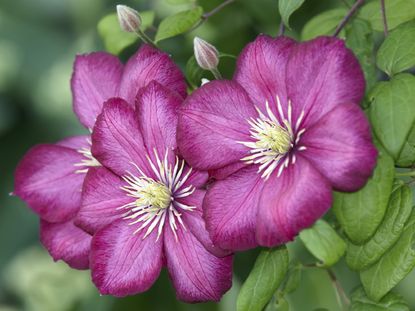Fall Flowering Clematis: Types Of Clematis That Bloom In Autumn


Gardens can begin to look tired and faded as summer ends, but nothing brings color and life back to the landscape like a luscious, late blooming clematis. While autumn blooming clematis varieties aren’t as plentiful as those that bloom early in the season, there are enough choices to add incredible beauty and interest as the gardening season winds down. Late blooming clematis plants are those that start blooming in mid to late summer, and then continue blooming until the first frost. Keep reading to learn about a few of the best fall blooming clematis.
Clematis Plants for Fall
Below are some common types of clematis that bloom in autumn:
- ‘Alba Luxurians’ is a type of fall flowering clematis. This vigorous climber reaches heights of up to 12 feet (4 m.). ‘Alba Luxurians’ displays grayish green leaves and big, white, green-tipped flowers, often with hints of pale lavender.
- ‘Duchess of Albany’ is a unique clematis that produces midsized pink, tulip-like flowers from summer until fall. Each petal is marked with a distinctive, dark purple stripe.
- ‘Silver Moon’ is appropriately named for the pale silvery lavender flowers that bloom from early summer to early autumn. Yellow stamens provide contrast for these pale, 6 to 8 inch (15-20 cm.) blooms.
- ‘Avante Garde’ puts on a show in summer and provides big, gorgeous blooms well into autumn. This variety is valued for its unique colors – burgundy with pink ruffles in the center.
- ‘Madame Julia Correvon’ is a stunner with intense, wine-red to deep pink, four-petaled blossoms. This late-blooming clematis puts on a show throughout summer and fall.
- ‘Daniel Deronda’ is a fall flowering clematis that produces gigantic, purple, star-shaped fall flowering clematis blooms in early summer, followed by a second flowering of somewhat smaller flowers in late summer through fall.
- ‘The President’ produces huge, deep bluish violet flowers in late spring and early summer, with a second flush in autumn. The big seed heads continue to provide interest and texture after the blooms have faded.
Gardening tips, videos, info and more delivered right to your inbox!
Sign up for the Gardening Know How newsletter today and receive a free download of our most popular eBook "How to Grow Delicious Tomatoes."

A Credentialed Garden Writer, Mary H. Dyer was with Gardening Know How in the very beginning, publishing articles as early as 2007.
-
 10 Best Apartment Plants To Turn Your Small Space Into An Oasis
10 Best Apartment Plants To Turn Your Small Space Into An OasisThe best apartment plants can lend an ambience of the tropics, brighten up a space, or add a touch of drama, and turn an apartment into a relaxing oasis.
By Amy Grant
-
 Grow a Bathroom Oasis: 8 Best Bathroom Plants With No Light or Low Light
Grow a Bathroom Oasis: 8 Best Bathroom Plants With No Light or Low LightSome apartment dwellers grow the best bathroom plants with no light or low light. Read how one of our favorite plant lovers does it in the big city.
By Teo Spengler